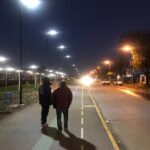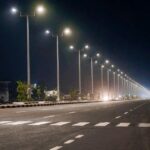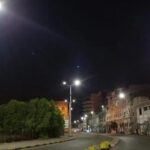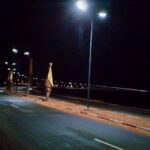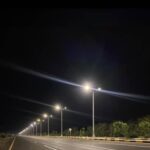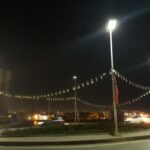There is a dramatic increase in the investment of energy-efficient street light upgrades and retrofits in companies and communities. What stands out most are the designs and nature of the various types of street light solar led. The marketplace has a wide range of lighting fixtures available to meet every system or project requirement.
The sudden shift from old-style High-Pressure Sodium lamp (HPS) lights to LED (Light Emitting Diode) lights in solar-powered streetlights has influenced the design and style of modern Luminaires.
Before you invest in a solar-powered street light system, it is best if you understand the anatomy of each part of the whole unit. In this article, we are going to look into the Anatomy of street light solar led Luminaires.
Street Light Solar LED Structure
Now let’s learn about the structures and organizations of the light sources you are likely to come across when selecting or designing your solar street light system.
The Standard Manual LED Luminaires
A standard LED luminaire has not much to show apart from the essential components that are interconnected to produce the light. This type of light source is common in split street lights designs. These are mostly overhead solar light fixtures and sometimes the decorative type depending on the application. Unlike the traditional fixtures, these products provide for directional lighting applications.
The product consists of:
- Replaceable LED units with LED Chips
- Individual optical lens for each LED
- Tempered cover glass
- Aluminum alloy or polymeric material housing or casing
- Mounting or connector
- Connecting cable
- Screws and gaskets
The finishing can be optional and varies, for instance, black, white, bronze, gray, and silver. The LED lighting wattage varies depending on your needs; you can choose either 20W, 30W, 40W, 60W, or 80W. As the wattage varies, the lumens also differ depending on the luminous efficacy.
The Standard Automatic LED Luminaires.
This category adds the element of automation in the systems to switch it on and off at the required time of the day, usually at dusk. Most manufacturers use transistor and sensor technology to achieve the automatic switching function. What is different in this category is the use of Light Dependent Resistor (LDR), photodiode, or phototransistor.
LED Luminaries with Diming
The difference between this type of lighting fixture and the standard one is that it is dimmable. Systems that fall under this category use automation to control the brightness of the lights produced.
The product consists of:
- Replaceable LED units with LED Chips
- Ambient Light Sensor (ALS)
- Individual optical lens for each LED
- Tempered cover glass
- electronic dimming drivers
- Aluminum alloy or polymeric material housing or casing
- Mounting or connector
- Screws and gaskets
The lamping varies depending on the LED type and distribution. The most common light distribution types are I, II, III, and V.
Luminaries may have the same compositions, but what differentiates them is the style. You will find the most common are square, circular or oval forms, architecturally forms and modern style (UFO, Flying fish, Cobra head style, Airplane-shaped, Eagle-like, Orchid-like and among others).
LED Luminaries with Motion Detection
The LED street lights that fall in this category are useful in situations where you need the activities below the lighting fixture to control the lights.
- Replaceable LED units with LED Chips
- Individual optical lens for each LED
- Passive Infrared Sensor (PIR motion sensor)
- Tempered cover glass
- Electronic dimming drivers
- Aluminum alloy or polymeric material housing or casing
- Mounting or connector
- Screws and gaskets
All in one Luminaire
This type of lighting fixture combines all components in a street light apart from the pole. These products provide minimal installation time and maximum ease of assembly.
Components in an all-in-one Luminaire includes:
- Replaceable LED units with LED Chips
- Rechargeable & replaceable Battery
- Individual optical lens for each LED
- Controller and inverter
- Tempered cover glass
- Electronic dimming drivers
- Aluminum alloy or polymeric material casing or housing
- Mounting or connector
- Screws and gaskets
In this design, no cables are needed for the product to work; you only need to mount the lighting fixture on the pole and use the right bulb for it to produce light.
The presence of inverters in luminaires shows that these units can operate under AC or DC solar power supply. In terms of visual comfort, some luminaries may use diffusers or optimized lenses. The design of these visual optics is such that they can’t affect the performance of the lighting source.
The material used in the lighting fixtures should offer corrosion and wind resistance. Luminaires with high degree IP ratings provide comprehensive protection against moisture.
The size of the light head highly depends on the components that the manufacturer intends to integrate into the fixture. Technology can influence the size with the improvisation of the elements. The type of control you want to achieve with the lighting (Light, Time or, Human Sensing) will determine the type of sensor to install in the lighting fixture.
The design of solar street light LED luminaires ensures that it is compatible with the most advanced LED technology on the market. Some LED bulb manufacturers, who are still in the solar street light, may decide to restrict the use of other lamps.
Designing your Luminaire has more selection activities other than choosing the wattage, Lumens, and type of bulb. You’ll need to take into account the luminous efficacy, the quality certification, waterproof and dustproof (IP Rating), working temperature, vandal-proof, lifespan (50000 – 100,000 hours), color temperature (3000K,4000K,6000K), Color Rendering Index (CRI) and among others.
Street Light Solar LED: Conclusion
The knowledge of the anatomy of streetlight solar LED luminaires is crucial in the design phase of your project. It defines the technology used and the features that you are likely to enjoy when in use.
Understanding the various components that you are likely to find inside the lighting fixture will help in the maintenance of the unit. With the specification in mind, it is easy to make any replacement or optimization.
The knowledge of the organization of various elements presently inside the luminaires will provide a foundation for saving energy and reducing the cost of the system.
You may also want to check Factors of Consideration in Solar Panels for Street Lights Costs.






